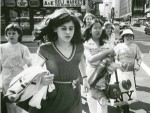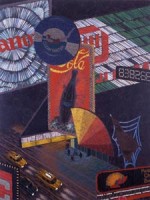Column Name
Title
Picturing New York, the two-partner (and two-part) show currently at the Museum of the City of New York, happens to dovetail nicely with the inaugural speaker series sponsored by the Liberal Arts Department this year, “A New York City Kaleidoscope.” In fact, the vibrant paintings and pastels of one of the artists, Yvonne Jacquette, could almost literally illustrate this title.
Body
Jacquette (b. 1934) and her late husband, Rudy Burckhardt (1914-90), observed New York City separately and together. While they employed different media, they both loved the city at night, capturing its vitality through unusual vantage points; at times they even worked together on films. Burckhardt came to New York from Switzerland, Jacquette from Pittsburgh. Meeting in 1961, they soon joined forces both as collaborators and as husband and wife. Though he was trained as a painter, Burckhardt worked primarily with black-and-white photographs and film, and Jacquette with pastel and oil paints. The two exhibitions stand on their own, though they certainly complement each other.
Since the Burckhardt will close soon (on April 13), I will address it first. Burckhardt’s work holds special interest for the Juilliard community because of his collaborations with musicians, dancers, and poets. In fact, the title of his show, “Street Dance: The New York Photographs of Rudy Burckhardt,” is not merely metaphorical, though it works on that level too. The artist, photographer, and filmmaker was influenced by Picasso, Mondrian, and many other pioneering artists whose work he came to know through his lifelong friendship with the poet, dancer, and dance critic, Edwin Denby.
The Swiss-born artist arrived in New York City in 1935. During his early days here, he was overwhelmed by differences in scale between Europe and the United States. Perhaps this is one reason that his early photos focused on details of architecture, pavement views of people’s feet, and their shadows. He also loved formal compositions featuring edges of buildings, views between and beyond them, and the facades of barbershops, sandwich shops, and storefronts. Like the cubists, he incorporated lettering, often highlighting advertising signs and billboards. The fact that he began shooting film before attempting still photography partly explains the feeling of movement he captured in the latter. Like choreographer and dancer Merce Cunningham, Burckhardt was fascinated by the movement of anonymous people—people who created their own choreography.
The 1940s and ’50s saw further explorations of scenes such as Astor Place, 1947. In this photo, a huge “Have a Coke” sign dominates the horizon, anchoring a bird’s-eye view of a traffic triangle in the center, with tiny human beings and autos scattered along the vertiginous two streets shot in reverse one-point perspective. The Flatiron Building, Summer, of the same year, has a similar composition. The landmark building casts a columnar shadow in the center, dividing the streets into two blindingly white diverging paths, dotted with minute pedestrians and cars. Emphasizing light-and-dark contrast, he lets the lettering of “The Bank of Savings” stand out, as he does the two flags waving from the rooftop of the building at right. The artist claimed that, unlike many photographers, he did not take numerous shots, but settled on one quite quickly. In Deli Market, 1978, he focused on one young girl, hurrying toward us, isolated in the midst of a crowd of girls of varying ages and types, all moving towards the viewer. Over her head the sign, “A & K Deli Market” promises “free delivery.” Obvious and prominent, it joins together with multiple other ads behind it, reflections in the window, and moving traffic. A spontaneous moment is captured, paradoxically frozen forever.
To turn to the colorful world of Burckhardt’s life partner, Yvonne Jacquette, is to move at once further away from individual human beings, and closer to the vibrancy of life. Her show, titled “Under New York Skies: Nocturnes by Yvonne Jacquette,” continues through May 4. Jacquette concentrates on the city’s tall buildings, lights, and the water of the harbor. She creates all her paintings from roofs or planes, and (unlike Burckhardt) she completed many in the studio. One startling photo in the show’s catalog captures the artist incongruously painting a brightly litMetropolitan Triptych, 2007 from her studio in Maine.
Jacquette became fascinated with the urban landscape at night, at least partly through seeing Burckhardt’s photos. It has been her life’s work since the 1970s—though New York City is not the only city she depicts.
She hardly ever includes people, but if she does, they are insubstantial pedestrians seen from afar. Her inspirations appear to come from Impressionism, Seurat, and the bright, whirling paintings of the Italian Futurists, especially Umberto Boccioni (1882-1916) or the Orphist works of Robert and Sonya Delaunay. This is especially apparent in Ola II, 1994, one of her most abstract paintings, emphasizing the shapes and motion of floating neon signs with partial lettering and numbers.
The earliest pastel in the show, East River View at Night I, 1976-77, was done from the hospital room of Edwin Denby. This meditation on life and death differs considerably from later works, such as Flatiron Intersection II, 1979. The latter comes closer to Burckhardt’s photo of the same subject. She, however, focuses on the humor of the small cake-slice view of the famous landmark, as it is reduced to just one corner of an empty-looking intersection with a few scattered figures and cars seen from above.
Chrysler Building Composite at Dusk II, 1997, a painting used in brochures for the show, is large (more than six feet high, and more than seven feet long) and iconic. It is immediately recognizable: the city seen from the Empire State Building. She emphasizes the strings of circular, rectangular, and zigzag lights that animate buildings, bridges, and traffic. This is what the traveler always sees when flying into any airport in the city—but here, from a much closer perspective.
Six films are also included in the show. All concentrate on aspects of New York City, most with music, including Debussy, Poulenc, Mozart, and Ives. One of them, Central Park in the Dark (1985), features a dance performance that feels a bit like some of the gang scenes in Leonard Bernstein’s West Side Story.
The Museum of the City of New York is located at 1220 Fifth Avenue (at 104th Street). Hours are Tuesday through Sunday, 10 a.m. to 5 p.m. The museum is closed on Mondays, except for major holidays. “Street Dance: The New York Photographs of Rudy Burckhardt” is on view through April 13. “Under New York Skies: Nocturnes by Yvonne Jacquette” continues through May 4.
Images from top: Rudy Burckhardt: Deli Market, 1978 (gelatin-silver print), courtesy of the estate of Rudy Burckhardt and the Tibor de Nagy Gallery, New York; Burckhardt: The Flatiron Building, Summer, 1947 (gelatin-silver print), Colby College Museum of Art. Yvonne Jacquette:Ola II, 1994 (oil on canvas), collection of Rob and Mary Ann Peglar; Jacquette: Chrysler Building Composite at Dusk, 1997 (oil on linen), collection of Rose and Morton Landowne. Photos courtesy of the Museum of the City of New York.








